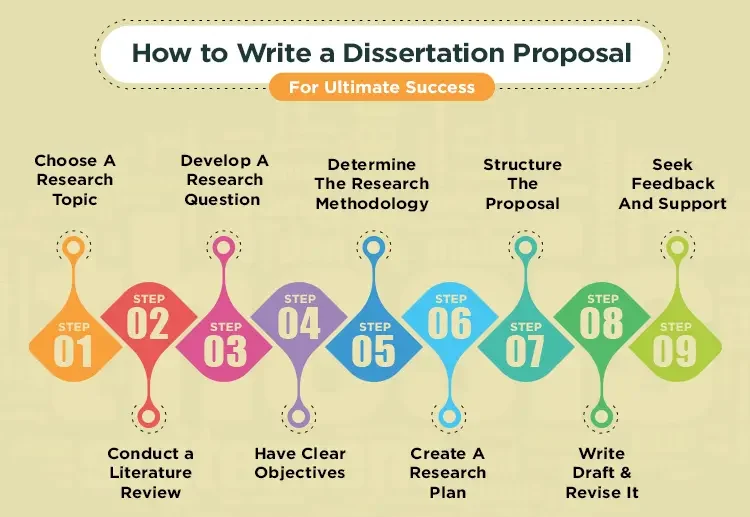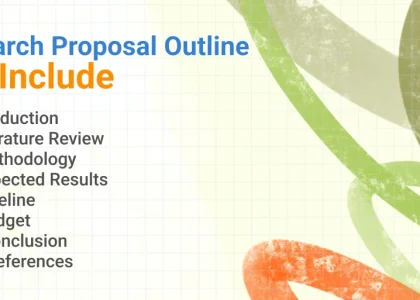How to Write a Dissertation Proposal? Writing a dissertation proposal is a crucial step in your academic journey. It sets the foundation for your research and is essential for getting your dissertation approved. This comprehensive guide will walk you through the process of crafting a compelling dissertation proposal, from understanding its purpose to polishing the final draft. Follow these steps to ensure your proposal is well-organized, clear, and persuasive.
Understanding the Purpose of a Dissertation Proposal
Before diving into the writing process, it’s important to understand why a dissertation proposal is necessary. A dissertation proposal:
- Outlines your research plan: It provides a detailed plan of your research, including the problem you’re addressing, your objectives, and your methodology.
- Demonstrates the significance of your research: It explains why your research is important and how it will contribute to the field.
- Serves as a roadmap: It guides you through the research process, helping you stay focused and organized.
- Secures approval: It must be approved by your advisor or dissertation committee before you can proceed with your research.

Step 1: Choose Your Research Topic
Identifying a Research Gap
Start by identifying a gap in the existing literature. Look for areas that have not been fully explored or questions that have not been answered. Consider your interests and strengths, as well as the relevance and feasibility of the topic.
Narrowing Down Your Focus
Once you’ve identified a broad area of interest, narrow it down to a specific research question or problem. Your topic should be manageable within the scope of your dissertation and align with your academic goals.
Step 2: Conduct a Literature Review
Gathering Sources
Collect relevant sources, including books, journal articles, and dissertations. Use academic databases like JSTOR, Google Scholar, and your university’s library resources.
Analyzing and Synthesizing Information
Analyze the sources to understand the current state of research on your topic. Look for patterns, trends, and gaps. Synthesize the information to provide a comprehensive overview of the existing literature.
Highlighting the Research Gap
Identify the gap your research will address and explain how your study will fill this gap. This sets the stage for your proposal and demonstrates the significance of your research.
Click here to place your order for Literature Review from our experts
Step 3: Formulate Your Research Questions and Objectives
Defining Your Research Questions
Your research questions should be clear, specific, and focused. They should guide your research and help you stay on track. Consider both the main question and sub-questions that will help you address different aspects of the problem.
Setting Your Objectives
Your objectives should outline what you aim to achieve with your research. They should be specific, measurable, achievable, relevant, and time-bound (SMART).
Step 4: Develop a Research Methodology
Choosing a Research Design
Decide on the overall research design, such as qualitative, quantitative, or mixed methods. Consider what will best address your research questions and objectives.
Selecting Data Collection Methods
Choose appropriate data collection methods, such as surveys, interviews, experiments, or archival research. Explain why these methods are suitable for your study.
Planning Data Analysis
Outline how you will analyze the data you collect. Describe the statistical or qualitative techniques you will use and justify your choices.
Click here to place your order for Research Methodology from our experts
Step 5: Write the Dissertation Proposal
Title Page
Include a title that clearly reflects the content and scope of your research. Add your name, your advisor’s name, and the date.
Abstract
Write a concise summary of your proposal, including the research problem, objectives, methodology, and significance. Keep it within 150-250 words.
Introduction
Introduce your research topic and provide background information. State the research problem and explain its significance. Clearly articulate your research questions and objectives.
Literature Review
Provide a detailed review of the existing literature on your topic. Highlight key studies, theories, and findings. Identify the research gap and explain how your study will contribute to the field.
Methodology
Describe your research design, data collection methods, and data analysis techniques. Justify your choices and explain how they align with your research objectives.
Timeline
Provide a timeline for your research, outlining key milestones and deadlines. This helps you stay organized and demonstrates your planning skills.
References
Include a list of all the sources you cited in your proposal. Use a consistent citation style, such as APA, MLA, or Chicago.
Click here to place your order for Dissertation Proposal from our experts
Step 6: Revise and Edit Your Proposal
Reviewing for Clarity and Coherence
Ensure your proposal is clear, well-organized, and logically structured. Each section should flow smoothly into the next, and your arguments should be coherent and persuasive.
Checking for Grammar and Style
Proofread your proposal for grammatical errors, typos, and stylistic inconsistencies. Use formal, academic language and avoid colloquialisms and jargon.
Seeking Feedback
Share your proposal with your advisor, peers, or a writing center for feedback. Use their suggestions to improve the clarity and quality of your proposal.
Finalizing the Draft
Make final revisions based on the feedback you received. Ensure your proposal is polished and professional before submitting it for approval.
FAQs about Writing a Dissertation Proposal
What is the difference between a dissertation proposal and a dissertation?
A dissertation proposal is a preliminary document that outlines your research plan, while the dissertation is the final, comprehensive report of your research findings. The proposal is written before you begin your research, and the dissertation is completed after your research is finished.
How long should a dissertation proposal be?
The length of a dissertation proposal can vary depending on your academic institution’s requirements. Generally, it ranges from 10 to 20 pages, including the title page, abstract, and references.
Can I change my research topic after my proposal is approved?
It’s possible to change your research topic after your proposal is approved, but you will need to seek approval from your advisor or dissertation committee. Changes should be justified and documented to ensure they align with your academic goals and research objectives.
What are common mistakes to avoid when writing a dissertation proposal?
Common mistakes include choosing a vague or overly broad topic, failing to conduct a thorough literature review, not clearly defining research questions and objectives, and neglecting to justify the chosen methodology. Additionally, poor organization, grammar errors, and lack of coherence can weaken your proposal.
Related Articles on Dissertation-Help.co.uk
- Top Dissertation Writing Tips
- Common Dissertation Mistakes and How to Avoid Them
- How to Conduct a Literature Review for Your Dissertation
Conclusion
Writing a dissertation proposal is a critical step in your academic journey. By following these detailed, step-by-step instructions, you can create a compelling and well-organized proposal that sets the foundation for your research. Remember to choose a relevant and manageable topic, conduct a thorough literature review, formulate clear research questions and objectives, develop a sound methodology, and revise your proposal thoroughly. With careful planning and attention to detail, you’ll be well on your way to a successful dissertation.







